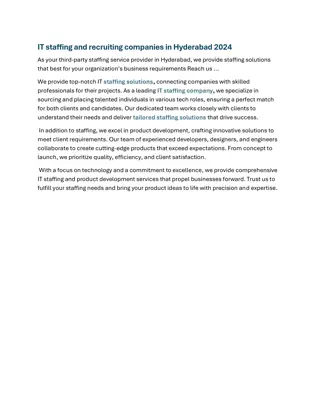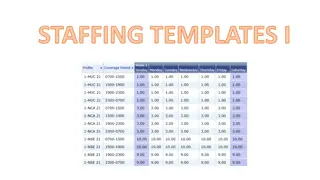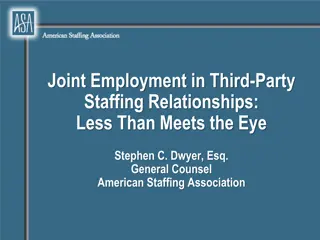Challenges in Staffing Classrooms with Qualified Teachers
The difficulty in staffing classrooms with qualified teachers is a prevalent issue in the education sector, backed by data from the Schools and Staffing Survey. High attrition rates among teachers contribute to this challenge, with turnover rates higher than many other professions. Schools often face a revolving door scenario, especially with foreign language teachers, as highlighted by the data analysis conducted by Richard M. Ingersoll.
Download Presentation

Please find below an Image/Link to download the presentation.
The content on the website is provided AS IS for your information and personal use only. It may not be sold, licensed, or shared on other websites without obtaining consent from the author.If you encounter any issues during the download, it is possible that the publisher has removed the file from their server.
You are allowed to download the files provided on this website for personal or commercial use, subject to the condition that they are used lawfully. All files are the property of their respective owners.
The content on the website is provided AS IS for your information and personal use only. It may not be sold, licensed, or shared on other websites without obtaining consent from the author.
E N D
Presentation Transcript
Why Schools Have Difficulty Why Schools Have Difficulty Staffing Their Classrooms Staffing Their Classrooms with Qualified Teachers? with Qualified Teachers? Richard M. Ingersoll Professor of Education and Sociology University of Pennsylvania and Consortium for Policy Research in Education
The Source of Data The Source of Data The Schools and Staffing Survey The Schools and Staffing Survey with the Teacher Follow with the Teacher Follow- -up Survey up Survey Conducted by the Census Bureau for the U.S. Conducted by the Census Bureau for the U.S. Department of Education Department of Education 8 Cycles over 2 Decades: 8 Cycles over 2 Decades: 1987 1987- -1989, 1990 1989, 1990- -1992, 1993 1992, 1993- -1995, 1999 2003 2003- -2005, 2007 2005, 2007- -2009; 2011 2009; 2011- -13, 2015 only) only) The largest source of information on teachers: The largest source of information on teachers: - -Sample: 55,000 teachers Sample: 55,000 teachers 12,000 schools 12,000 schools - -Representing all 50 states Representing all 50 states 1995, 1999- -2001, 2001, 13, 2015- -16 (prelim. 16 (prelim.
Attrition in Teaching is Higher Than in Many Attrition in Teaching is Higher Than in Many Occupations/Professions Occupations/Professions (Among 1993 College Grads Who Entered Selected Occupations by 1997, Percent Gone From Occupation by 2003) 79 Secretaries 49 Child Care Workers 49 Paralegals 45 Correctional Officers 30 TEACHERS 28 Police 23 Architects 19 Nurses 19 Lawyers 16 Engineers 14 Pharmacists 0 20 40 60 80 100 Percent Source: Ingersoll, R. & Perda, D. forthcoming. How High is Teacher Turnover and is it a Problem? Consortium for Policy Research in Education, Univ Penn
Schools Suffer from a Revolving Door Schools Suffer from a Revolving Door (Numbers of Public School Teachers in Transition Into and Out of Schools Before and After 2011-12 School Year) Hires 343,955 Teaching Force 3,385,171 Turnover 531,340 At Beginning of School Year During School Year After End of School Year Source: Ingersoll, R., original analyses of 2011-13 Schools and Staffing Survey /Teacher Followup Survey
Schools Suffer from a Revolving Door of Schools Suffer from a Revolving Door of Foreign Language Teachers Foreign Language Teachers (Numbers of Public School Foreign Language Teachers in Transition Into and Out of Schools Before and After 2011-12 School Year) Hires 15,607 Teaching Force 98,993 Turnover 14,843 At Beginning of School Year During School Year After End of School Year Source: Ingersoll, R., original analyses of 2011-13 Schools and Staffing Survey /Teacher Followup Survey
Some Costs and Consequences of Some Costs and Consequences of High Teacher Turnover High Teacher Turnover Leads to Teacher Shortages Harms Student Achievement Undermines School Cohesion Costly in Time and Money
Beginning Teachers Leave Teaching at Beginning Teachers Leave Teaching at Highest Rates Highest Rates (Cumulative Percent Teacher Attrition, by Years of Experience: 1993-2003 Less than 1 year 11.9 Less than 2 years 23 Less than 3 years 30.6 Less than 4 years 39.1 Less than 5 years 44.6 0 20 40 Percent 60 80 100 Source: Perda, D. 2013. Transitions Into and Out of Teaching: A Longitudinal Analysis of Early Career Teacher Turnover. PhD Dissertation, Univ of Penn.
Schools Vary in Teacher Turnover Schools Vary in Teacher Turnover (Percent Annual Public School Teacher Turnover, by Selected School Characteristics) 15 All Public Large/Suburban/Not- poor 11 Small/Suburban/Not- Poor 16 19 Large/Urban/Poor 22 Small/Rural/Poor 26 Small/Urban/Poor 0 5 10 15 20 25 30 Percent Percent Source: Ingersoll, R., original analyses of 2000-2001 Teacher Followup Survey
Job Dissatisfaction a Leading Factor Behind Job Dissatisfaction a Leading Factor Behind Teacher Turnover Teacher Turnover (Percent Public School Foreign Language Teachers Reporting that Various Reasons Were Important for their Turnover, 2012-13) Retirement 11.3 School Staffing Action 28.9 Family or Personal 39.5 To Pursue Other Job 36.7 Dissatisfaction 51.6 0 20 40 60 80 100 Percent Source: Ingersoll, R., original analyses of 2012-13 Teacher Followup Survey
Teachers Working Conditions are Important Teachers Working Conditions are Important for Turnover for Turnover (Of Those Public School Foreign Language Teachers Who Moved From or Left Their School Because of Dissatisfaction, Percent Reporting Particular Sources of Dissatisfaction, 2012-13) Student Discipline Problems 74 Poor Salary/Benefits 68 Classroom Intrusions 64 Lack of Influence & Autonomy 60 Dissatisfied with Administration 57 Dissatisfied with Accountability/Testing 57 Poor Facilities & Resources 38 Dissatisfied with Tching Assignment 39 Class Sizes too Large 34 0 20 40 60 80 100 Percent Source: Ingersoll, R., original analyses of 2012-13 Teacher Followup Survey
The Pedagogical Preparation of The Pedagogical Preparation of Teachers Has Positive Effects on Teachers Has Positive Effects on Teacher Retention Teacher Retention Relationship to Attrition Type of Pedagogical Preparation Coursework in Teaching Methods Less Attrition Practice Teaching Less Attrition Preparation in Selecting Course Materials Less Attrition Coursework in Child Psych/Learning Theory Less Attrition Formal Feedback on Teaching Less Attrition Source: Ingersoll, Merrill & May. 2014. What Are the Effects of Teacher Education and Preparation on Beginning Teacher Attrition? Philadelphia: Consortium for Policy Research in Education
What Kinds of Induction Supports Do What Kinds of Induction Supports Do Beginning Teachers Receive? Beginning Teachers Receive? 12) (Percent 1 (Percent 1st st- -Year Teachers Who Received Various Supports (2011 Year Teachers Who Received Various Supports (2011- -12) Regular Contact with Admin. 80 Mentor 70 Beginners' seminars 60 Common Planning Time w Colleagues 55 Teacher aide 28 Reduced Teaching Load 13 0 20 40 60 80 100 Percent Source: Ingersoll, R., original analyses of 2011-12 Schools and Staffing Survey.
Induction & Support for Beginning Induction & Support for Beginning Teachers Has Positive Effects Teachers Has Positive Effects o We examined 15 best empirical studies, since the We examined 15 best empirical studies, since the 1980s 1980s o Three sets of outcomes: Three sets of outcomes: oteacher commitment and retention teacher commitment and retention oteacher classroom instructional practices teacher classroom instructional practices ostudent achievement student achievement o Most of the studies reviewed showed positive Most of the studies reviewed showed positive impacts of induction impacts of induction Source: Ingersoll , R. and Strong, M. 2011. "The Impact of Induction and Mentoring for Beginning Teachers: A Critical Review of the Research. Review of Educational Research. 81(2) 201-233 .
Teacher Leadership Has Positive Teacher Leadership Has Positive Effects Effects o We analyzed national data on the impact of We analyzed national data on the impact of teachers input into school decision teachers input into school decision- -making making o Two sets of outcomes: Two sets of outcomes: oteacher retention teacher retention ostudent achievement student achievement o The data showed positive impacts of teacher The data showed positive impacts of teacher leadership on both outcomes leadership on both outcomes o Teachers influence over student behavior & Teachers influence over student behavior & discipline policies has the discipline policies has the strongest impact strongest impact Source: Source: Ingersoll, Dougherty & Sirinides, P. (2017). School Leadership Counts. Santa Cruz, CA: New Teacher Center.
For Further Information, Copies of For Further Information, Copies of Articles, Reports, etc.: Articles, Reports, etc.: www.gse.upenn.edu/faculty/ingersoll www.gse.upenn.edu/faculty/ingersoll rmi@upenn.edu rmi@upenn.edu
























